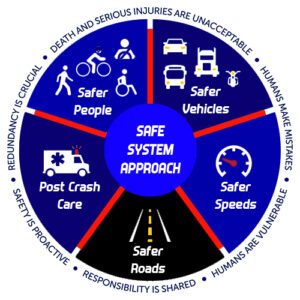
Introduction to The MIS Safe System:
In an era marked by rapid urbanization and increasing mobility, road safety has become a paramount concern for societies worldwide. Every year, millions of lives are lost, and countless others are affected by road accidents. In response to this global issue, the concept of the Safe System has emerged as a transformative approach to minimizing road casualties. The MIS Safe System represents a paradigm shift in road safety, aiming not only to prevent accidents but also to mitigate their consequences. In this section, we will explore the key principles and strategies of the MIS Safe System and its potential to revolutionize Road Safety.
What is required for The MIS Safe System – Revolutionizing Road Safety:
-
Holistic Approach: The MIS Safe System stands apart from traditional road safety approaches by adopting a comprehensive and holistic perspective. Instead of solely focusing on driver behaviour or infrastructure, the MIS Safe System acknowledges that accidents are a result of a complex interaction between multiple factors. It recognizes the roles played by road users, vehicles, infrastructure, and the overall system. By addressing all these elements, the Safe System aims to create a safe and forgiving environment that safeguards all road users.
-
Shared Responsibility: The MIS Safe System promotes the idea of shared responsibility for road safety. It recognizes that individuals, organizations, and governments all have a role to play in preventing accidents and minimizing harm. Road users are encouraged to adopt responsible behaviour, such as obeying traffic rules, avoiding distractions, and driving defensively. Vehicle manufacturers are urged to prioritize safety features and technologies that protect occupants and vulnerable road users. Furthermore, governments are expected to design and maintain safe infrastructure, enforce regulations, and develop comprehensive road safety policies.
-
Safe Speeds: One of the fundamental principles of the MIS Safe System is the importance of safe speeds. Excessive speed is a significant contributor to accidents and the severity of their consequences. The MIS Safe System emphasizes the need to set speed limits that consider the context of the road, such as its function, surrounding land use, and the vulnerability of road users. Implementing appropriate speed management measures, such as traffic calming measures and intelligent speed adaptation, plays a crucial role in reducing the risk of accidents and minimizing their impact.
-
Safe Vehicles: Another critical aspect of the MIS Safe System is the emphasis on safe vehicles. Modern safety technologies, including advanced driver assistance systems (ADAS) and crash avoidance systems, have the potential to prevent or mitigate the severity of accidents. The MIS Safe System encourages the adoption of such technologies, as well as robust vehicle safety standards and regulations. Additionally, the MIS Safe System promotes the use of active and passive safety features, such as seat belts, airbags, and crash-worthy designs, to protect occupants and vulnerable road users.
-
Safe Infrastructure: Safe infrastructure plays a pivotal role in the MIS Safe System approach. Well-designed roads, intersections, and traffic management systems contribute to preventing collisions and reducing their severity. The MIS Safe System advocates for infrastructure that accounts for the diversity of road users, including pedestrians, cyclists, and motorcyclists. Features such as separated bike lanes, pedestrian crossings, and traffic calming measures can significantly enhance safety and reduce conflicts between different modes of transport.
-
Post-Crash Care and Rehabilitation: While prevention is the primary focus of the MIS Safe System, it also recognizes the need for effective post-crash care and rehabilitation. Prompt emergency response, well-equipped hospitals, and rehabilitation services can make a difference in reducing the long-term impacts of collisions. The MIS Safe System promotes collaboration between healthcare providers, law enforcement, and transport agencies to ensure efficient and effective post-crash care.
Conclusion:
The MIS Safe System represents a transformative approach to road safety, aiming to create an environment that prevents collisions and minimizes consequences. By adopting a holistic perspective, promoting shared responsibility, and addressing factors such as speed, vehicles, and infrastructure, the MIS Safe System has the potential to revolutionize road safety.
![]()
